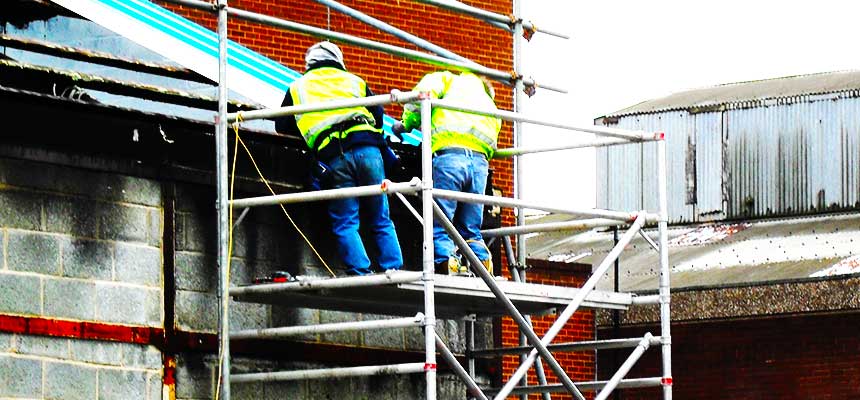Enhancing the Criteria: Contemporary Framework Approaches for Businesses
In the modern fast-paced building landscape, commercial scaffolding has surfaced as an indispensable resource for companies seeking to improve security and effectiveness on their work sites. Whether it's towering skyscrapers to sprawling retail center renovations, effective scaffolding solutions not just support the structural integrity of a construction while also promote a safer employment environment for crews. Grasping the various kinds of scaffolding, the security protocols involved, and the compliance requirements is essential for any business engaged in construction.
With the complexities of modern projects, the selection of scaffolding can profoundly impact the total success and security of a build. Whether it's balancing the logistical demands of a busy business site or ensuring the stability and reliability of the scaffolding system, having the right knowledge can result in substantial improvements in productivity and project timelines. This piece will examine essential aspects of business scaffolding, from its function in boosting work site security to the different forms on offer and the important security regulations that must be adhered to in the industry.
Grasping Industrial Scaffolding
Industrial scaffolding is a provisional structure that holds up workers and materials during construction, remodeling, or repair projects in commercial settings. It supplies essential access and guarantees safety for laborers working at heights, allowing for efficient execution of tasks that would otherwise be difficult or impossible. This infrastructure is essential for various types of buildings, from office complexes to store spaces, ensuring that projects can progress easily and securely.
Various types of scaffolding can be used in business projects, including frame scaffolding, assemblable scaffolding, and suspended scaffolding. Each type is crafted to meet particular needs based on project scale, site conditions, and the nature of the work being performed. Choosing the appropriate scaffolding system is crucial for optimizing workflow and boosting accessibility, which ultimately leads to a favorable project completion.
The importance of industrial scaffolding extends past mere access; it holds a significant role in job site safety. visit the site -erected scaffold minimizes risks associated with working at heights, such as falls and injuries. Adherence with safety regulations and proper training for workers are essential aspects to make certain the scaffolding serves its purpose effectively. Comprehending the multiple components and regulations surrounding industrial scaffolding helps businesses maintain stringent safety standards on job sites.
### Scaffolding Safety and Compliance
Safety measures and adherence to regulations are vital elements in scaffolding operations, particularly in business projects where risks can greatly impact workers and overall productivity. Complying with stringent safety regulations and standards is not merely a legal obligation but a vital aspect of maintaining an efficient job site. Guaranteeing that all scaffolding setups meet local, state, and federal regulations minimizes the likelihood of accidents and helps to create a secure work environment for all staff involved.
Regular inspections and risk assessments serve an important role in scaffolding safety. Such assessments help to recognize potential hazards and ensure that scaffolding systems are erected and maintained properly. Workers should be trained to spot risks associated with scaffolding, such as structural instability or improper assembly, allowing for proactive measures to be implemented. By promoting a culture of safety and vigilance, businesses can greatly reduce the number of incidents on site.
Additionally, compliance with OSHA regulations is non-negotiable in the scaffolding industry. These regulations outline specific requirements for scaffolding design, assembly, and usage to protect workers from accidents and injuries. Companies must ensure that all crew members are familiar with these regulations and that their work practices show compliance. Investing in thorough training programs and safety workshops will not only help to meet compliance standards but also contribute to a more skilled and aware workforce, ultimately enhancing job site safety and efficiency.
Opting for the Suitable Scaffold Options
Selecting the appropriate scaffolding solution is vital for the achievement of any business project. It starts with evaluating the particular needs of your job, such as the type of work being conducted, the elevation of the buildings, and the surroundings in which the scaffolding will be used. For example, high-rise buildings require robust and reliable scaffolding systems that can withstand heavy weights, while commercial and office developments may need more versatile solutions that can adapt to varying layouts and styles.

Take into account the various types of scaffold, such as modular, pipe and fitting, and engineered scaffold. Every form offers distinct advantages depending on your project's requirements. Modular scaffolding is known for its versatility and ease of assembly, while tube and clamp systems provide a tailored solution ideal for complex structures. Assessing the particular features that every type offers, such as weight tolerance, ease of setup, and flexibility, can help you create an informed decision customized to your job's demands.
Ultimately, seeking advice from a qualified scaffold company can offer important insights and advice. Their expertise can help you manage the complexities of scaffolding selection and ensure compliance with safety regulations. By partnering with skilled experts, you not only streamline the planning and implementation process but also enhance the overall safety and effectiveness of your project, resulting in favorable outcomes.